[Break Time! is a series of posts about video games that Rick has spent entirely too much time with over the years.]
I’m a game collector. It’s not rare for me to have multiple copies of the same game in my collection, since I often buy games in large lots along with other games. It is rare for me to buy two copies of a new game, though. Star Ocean 2: The Second Story is the only game I have ever bought twice – while it was still a new game.
Why did I buy the game twice? The short answer is that my copy got damaged to the point that it wouldn’t play anymore. Here’s the long answer.
Star Ocean: The Second Story (which I’ll call SO2 from now on) is a Japanese-style role playing game for the original Playstation.
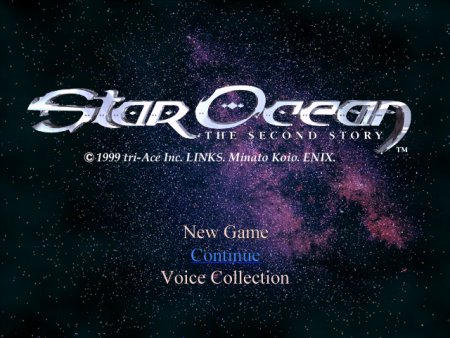
Title screen
SO2 boasts some unique gameplay elements (for its time). First, there’s the combat system.
In the twentieth century, most Japanese-style role playing games had what I’ll call a “whack-a-mole” combat system.*** Your party would stand on one side of a battlefield, while your enemy would line up on the other. You and the enemy would take turns attacking each other. Sometimes, the only actions you could take would be to choose what enemy to attack, or use an item or magic spell. Some of these combat systems made your position on the field important, and some didn’t. But these systems, by and large, had one thing in common – extremely tedious combat. There’s only so many times you can mindlessly select “attack” from a menu before you want to throw the controller down onto the floor and stomp on it. Add to this the fact that battles could occur randomly and frequently, and these games could get rather frustrating.
SO2, though, features a real-time combat system. You control one of your four combatants, while the computer controls the other three. You’re free to run around the battlefield and attack enemies. You can evade many attacks by … moving out of the way. You can surround an enemy and beat him to a pulp. (But they can do the same to you, so you have to be careful!)
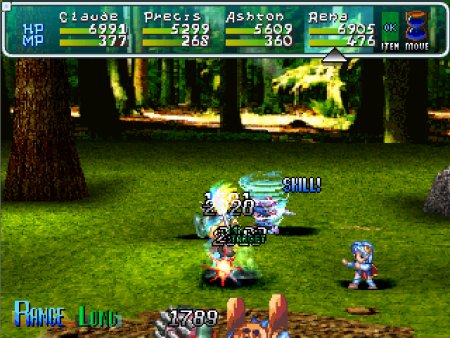
Combat
Combat is fast and furious. Characters have many special moves, which you use much like the moves in a fighting game. Battles are usually fairly short, and there’s always something going on.
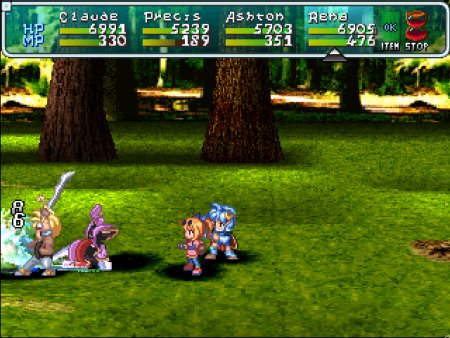
Combat
If your characters are strong enough, you can sometimes sit back and watch the computer kick enemy butt. (This is good for random battles with weak enemies.)
In short, combat in SO2 is actually entertaining, which means that the battles necessary to progress through the game’s storyline don’t seem like a chore.
Speaking of the story, that’s another area where SO2 tries some new things. For one, there are two main characters. You choose your main character at the beginning of the game, and the story is told from that character’s perspective. The events in the story are often similar for both characters, since the two meet each other within the first hour of play. Your choice of main character, though, dictates how you’ll see the story unfold. Some events will only be seen by one of the characters, and some secondary characters will join you only if you’re playing the right main character.
You will see many of the usual Japanese-style RPG cliches. There’s a young girl with a mysterious past and strange powers, a world to save, etc. – but SO2 keeps it entertaining.
You can also influence the outcome of the story. SO2 has about eighty or so different endings (you get more than one “ending” per game – each of your party members gets one) – which depend on your actions in the game. Most Japanese-style RPGs have a single ending. You either get “the ending” at the end of the game, or you die in battle somewhere and get a “game over” screen. But SO2 allows you to interact with your party members. What you say to them (or do to them) influences how much they like you, and will change their fate at the end of the game. You can even pair characters up at the end of the game if you like. How? Mainly through something called “Private actions”:
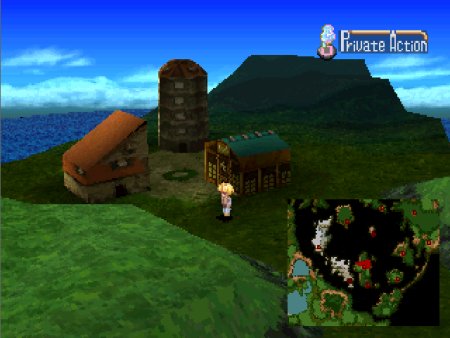
Private actions
When you enter a town, you usually have the option for your party members to enter either as a group or individually. Entering the town individually starts a “private action”, and you can go find your characters in the town and talk to them.
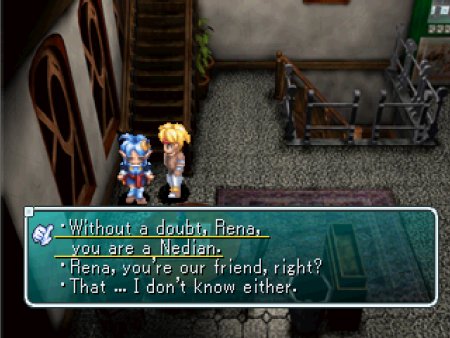
Private actions
Your choices in these conversations – or your actions in the little quests they may want you to go on – cause characters to like you more or less. There are even characters that may join your party (or not) as a result of these private actions. This adds a lot of variety to the game.
There are mini games (a bunny race, a combat arena, an “Iron Chef” cooking competition) and side quests to keep you entertained as well. You can build custom weapons and armor using items you find or buy. You can customize your characters by buying all sorts of “skills”. You can write novels to earn money or influence how much characters like each other. You can even make your character into a pickpocket who can steal items from the people you meet in your travels. Just don’t steal in front of (or from) your other characters, or they’ll start to dislike you! There’s also a huge bonus dungeon for those who want even more challenge. You won’t be hurting for something to do in this game!
The game isn’t quite flawless, though. The English translation leaves a little to be desired. There are random battles, so it’s sometimes difficult to explore areas without getting disoriented by combat. Plus, the game crashes occasionally in the last dungeon (so make sure to save your game!)
Even with those flaws, Star Ocean: The Second Story is an excellent game. And it’s one I’ve probably spent far too much time on over the years.
***Sadly, this trend of boring, annoying combat systems has continued into the twenty-first century. I’m looking at you, Xenosaga!
